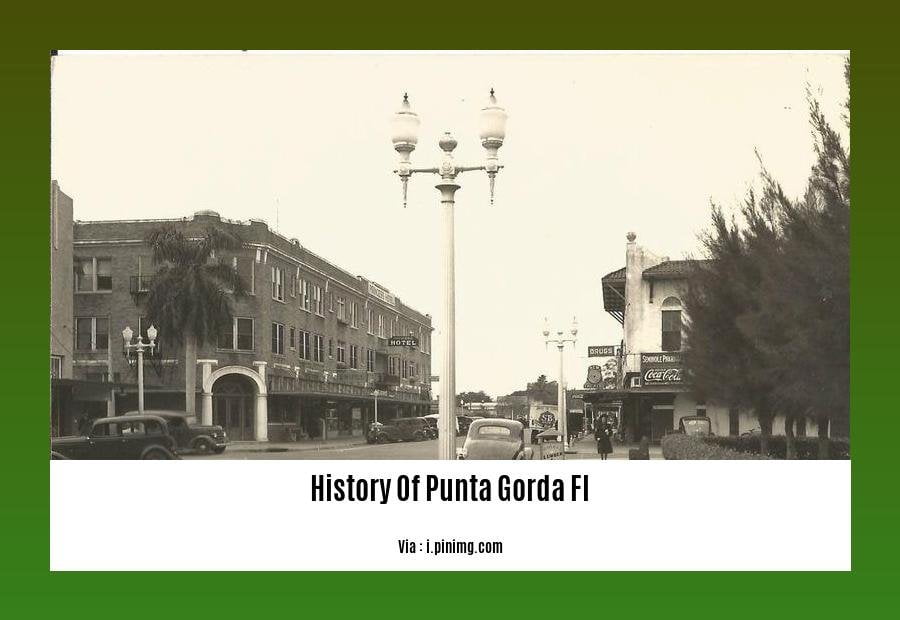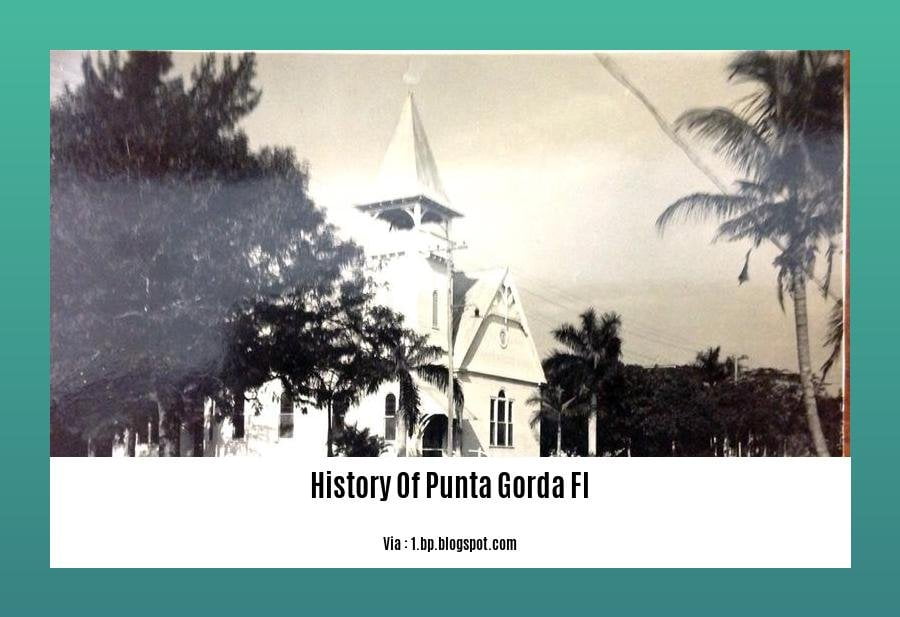Embark on a captivating journey through time as we unveil the rich history of Punta Gorda, FL, in our article, “A Journey Through Time: Uncovering the Rich History of Punta Gorda, FL.” This charming city on Florida’s Gulf Coast boasts a captivating past, from its humble origins as a fishing village to its transformation into a thriving cultural hub. Join us as we delve into the captivating tales and hidden gems that make Punta Gorda a treasure trove for history enthusiasts.
Key Takeaways:
Punta Gorda, Florida’s settlement began in 1882 by Union army veterans, the Howard brothers.
The town’s growth accelerated with the arrival of the railroad in the late 1890s.
Punta Gorda formally became a town in 1887.
The Punta Gorda Herald newspaper has been chronicling the city’s growth since its inception.
Punta Gorda gained city status in the year 1900.
History of Punta Gorda, FL

Punta Gorda, nestled along the scenic Charlotte Harbor, is a city steeped in rich history and vibrant culture. From its humble beginnings as a small fishing village to its transformation into a thriving metropolis, Punta Gorda’s journey through time is a captivating tale worth exploring.
The Early Settlers: Planting the Seeds of a City
The history of Punta Gorda, FL begins with the arrival of the Howard brothers, Union Army veterans, who settled in the area around 1882. Drawn by the region’s natural beauty and economic potential, they established a trading post, laying the foundation for what would become a bustling town.
The Railroad Spurs Growth and Prosperity
A significant turning point in Punta Gorda’s history came with the arrival of the railroad in the 1890s. The railroad connected Punta Gorda to major cities, facilitating the transportation of goods and people, leading to a surge in growth and prosperity.
Incorporation and the Rise of a City
In 1887, Punta Gorda took a significant step forward by incorporating as a town, signaling its growing importance and autonomy. The town’s development was further bolstered by the establishment of the Punta Gorda Herald newspaper in 1883, which chronicled the town’s progress and became a vital source of information for residents.
The 20th Century: Embracing Progress and Modernization
The 20th century brought significant transformations to Punta Gorda. In 1900, the town officially became a city, reflecting its growing population and economic vitality. The city continued to expand and modernize, with the construction of new buildings, infrastructure improvements, and the establishment of thriving businesses.
Preserving the Past, Embracing the Future
Today, Punta Gorda stands as a testament to its rich past, while embracing the opportunities of the future. The city has carefully preserved its historical landmarks, including the Punta Gorda Woman’s Club, the A.C. Freeman House, and the Punta Gorda Historical Museum, ensuring that its heritage remains a vital part of its identity.
As Punta Gorda continues to evolve, its unique blend of history and progress ensures that its story will continue to captivate visitors and residents alike for generations to come.
Did you ponder the intriguing history of Puerto Princesa? Explore the rich tapestry of its past and discover the fascinating tales that have shaped this vibrant city. Visit the history of Puerto Princesa.
Unravel the enigmatic history of Punta Gorda and delve into the captivating narratives that have shaped this remarkable destination. Embark on a journey through time as you uncover the secrets and stories that lie within its storied past. Explore the history of Punta Gorda.
The Punta Gorda Woman’s Club being founded in 1891

Punta Gorda is adorned with captivating historical landmarks, one of the most prominent being the Punta Gorda Woman’s Club. Originally formed in 1891, the Woman’s Club holds a special place in the city’s narrative, representing the spirit of community and empowerment.
Picture this: A group of like-minded women in the late 19th century, recognizing the need for intellectual and social engagement, came together to establish a haven for women’s growth and connection. In 1891, their vision materialized, giving birth to the Punta Gorda Woman’s Club.
Initially, the club served as the area’s first community library, symbolizing the women’s commitment to fostering knowledge and literacy. Over the years, the club evolved, becoming a hub for social gatherings, cultural events, and charitable initiatives.
In 1925, three local women’s organizations—the Fortnightly Club, the Married Ladies Club, and the Woman’s Civic Club—merged to form the present-day Punta Gorda Woman’s Club, consolidating their collective strength and influence.
The club’s unwavering dedication to community service and women’s empowerment earned it a well-deserved spot on the National Register of Historic Places in 1991, cementing its status as a local treasure.
Today, the Punta Gorda Woman’s Club stands as a testament to the enduring legacy of its founding members. Housed in a beautiful historic building on Sullivan Street, the club continues to host a variety of events, including meetings, social gatherings, and musical performances.
Key Takeaways:
- The Punta Gorda Woman’s Club was established in 1891 by a group of forward-thinking women seeking intellectual and social engagement.
- Originally serving as the area’s first community library, the club evolved into a hub for social gatherings, cultural events, and charitable initiatives.
- In 1925, three local women’s organizations merged to form the present-day Punta Gorda Woman’s Club, solidifying its impact on the community.
- Recognized for its contributions, the club was listed on the National Register of Historic Places in 1991, earning its place among Punta Gorda’s cherished landmarks.
- The club remains an active center for community events and women’s empowerment, honoring the legacy of its founders.
Relevant Sources:
Punta Gorda Woman’s Club
Punta Gorda Woman’s Club Building
The construction of the Punta Gorda Hotel in 1926
In 1924, Barron Collier, a savvy entrepreneur and land developer, set his sights on Punta Gorda, a charming city nestled on the shores of Charlotte Harbor. Recognizing its potential as a tourism destination, Collier purchased the Hotel Punta Gorda, a once-grand landmark that had fallen into disrepair.
With a keen eye for detail and a deep appreciation for architectural heritage, Collier embarked on an ambitious renovation project, injecting a quarter of a million dollars into restoring the hotel to its former glory. Under his stewardship, the Punta Gorda Hotel underwent a remarkable transformation, emerging as a beacon of elegance and sophistication.
The hotel’s grand reopening in 1926 marked a pivotal moment in Punta Gorda’s history. Collier’s vision had come to life, and the Punta Gorda Hotel stood proudly as a symbol of the city’s resurgence. Its opulent lobby, adorned with gleaming chandeliers and marble floors, welcomed guests with an air of grandeur.
Beyond its striking facade, the hotel boasted 100 well-appointed guest rooms, each offering a breathtaking view of the harbor or the city’s vibrant streets. Amenities such as a swimming pool, tennis courts, and a golf course further enhanced the guest experience, making the Punta Gorda Hotel a premier destination for discerning travelers.
Collier’s investment in the Punta Gorda Hotel not only revitalized the city’s tourism industry but also sparked a wave of development that transformed Punta Gorda into a thriving metropolis. The hotel’s success attracted new businesses and residents, contributing to the city’s economic growth and prosperity.
To this day, the Punta Gorda Hotel remains an iconic landmark, a testament to Barron Collier’s vision and the enduring spirit of Punta Gorda.
Key Takeaways:
- Barron Collier purchased the Hotel Punta Gorda in 1924 and invested $250,000 in renovations.
- The hotel reopened in 1926 as the Hotel Charlotte Harbor, boasting 100 guest rooms and various amenities.
- The hotel’s revival played a pivotal role in Punta Gorda’s resurgence as a popular tourism destination.
- Collier’s investment sparked a wave of development, transforming Punta Gorda into a thriving metropolis.
Sources:
[1] https://explorepuntagorda.com/live-here/our-history/
[2]
The City’s Evolution into a Popular Tourist Destination in the 1950s
In the 1950s, Punta Gorda experienced a remarkable transformation from a small fishing village to a vibrant tourist destination. This metamorphosis can be attributed to several key factors that converged to create the perfect storm of growth and development.
A Symphony of Sun, Sand, and Sea
Punta Gorda’s idyllic location, nestled along the sun-kissed shores of Charlotte Harbor and the shimmering Gulf of Mexico, played a pivotal role in its ascent as a tourist haven. The city’s pristine beaches, inviting waters, and balmy climate provided a compelling allure for vacationers seeking respite from the hustle and bustle of city life.
Unlocking the Gateway to Paradise
The completion of the Tamiami Trail in 1928 marked a turning point in Punta Gorda’s accessibility. This vital artery connected the city to major population centers, opening up a gateway for tourists to discover the hidden gem that lay at the end of the road.
A Canvas of Alluring Attractions
Punta Gorda’s transformation into a tourist destination was further fueled by the development of captivating attractions that catered to the diverse interests of visitors. The construction of the Fishermen’s Village in the 1950s created a vibrant waterfront hub, teeming with shops, restaurants, and entertainment venues that exuded a unique Old Florida charm.
Marketing the Magic of Punta Gorda
The city’s leaders recognized the importance of promoting Punta Gorda’s allure to potential tourists. They embarked on a strategic marketing campaign, highlighting the city’s natural beauty, rich history, and endless recreational opportunities. This concerted effort paid off, attracting visitors from far and wide who were eager to experience the magic of Punta Gorda for themselves.
Key Takeaways:
- Strategic location: Punta Gorda’s idyllic setting, nestled along the Gulf of Mexico and Charlotte Harbor, provided a picturesque backdrop for a tourist haven.
- Tamiami Trail: The completion of the Tamiami Trail in 1928 opened up a gateway for tourists to easily access Punta Gorda.
- Fishermen’s Village: The development of Fishermen’s Village in the 1950s created a vibrant waterfront hub, attracting visitors with its unique Old Florida charm.
- Marketing efforts: Punta Gorda’s leaders effectively marketed the city’s natural beauty, rich history, and diverse attractions, attracting tourists from far and wide.
Sources:
- Punta Gorda History
- Fishermen’s Village
FAQ
Q1: When was Punta Gorda, Florida established?
A1: Punta Gorda was established in 1884 when surveyor Kelly Harvey divided the Trabue subdivision.
Q2: Who was responsible for the initial settlement of Punta Gorda?
A2: The Howard brothers, Union Army veterans, were responsible for the initial settlement of Punta Gorda around 1882.
Q3: What spurred the growth of Punta Gorda?
A3: The arrival of the railroad about ten years after the initial settlement spurred the growth of Punta Gorda.
Q4: When was Punta Gorda incorporated as a city?
A4: Punta Gorda was incorporated as a city in 1900.
Q5: What is the history of the Punta Gorda Woman’s Club?
A5: The Punta Gorda Woman’s Club was formed in 1925 by consolidating three local women’s clubs; it was originally the area’s first community library and was added to the National Register of Historic Places in 1991.
- Unlock Water’s Symbolism: A Cross-Cultural Exploration - April 20, 2025
- Identify Black and White Snakes: Venomous or Harmless? - April 20, 2025
- Unlocking Potential: Origins High School’s NYC Story - April 20, 2025















